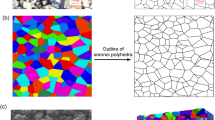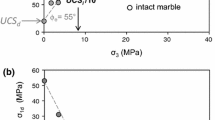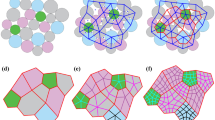Abstract
A new constitutive model for intact rock is presented recognising that rock strength, stiffness and stress–strain behaviour are affected by the size of the rock being subjected to loading. The model is formulated using bounding surface plasticity theory. It is validated against a new and extensive set of unconfined compression and triaxial compression test results for Gosford sandstone. The samples tested had diameters ranging from 19 to 145 mm and length-to-diameter ratios of 2. The model captures the continuous nonlinear stress–strain behaviour from initial loading, through peak strength to large shear strains, including transition from brittle to ductile behaviour. The size dependency was accounted for through a unified size effect law applied to the unconfined compressive strength—a key model input parameter. The unconfined compressive strength increases with sample size before peaking and then decreasing with further increasing sample size. Inside the constitutive model two hardening laws act simultaneously, each driven by plastic shear strains. The elasticity is stress level dependent. Simple linear loading and bounding surfaces are adopted, defined using the Mohr–Coulomb criterion, along with a non-associated flow rule. The model simulates well the stress–strain behaviour of Gosford sandstone at confining pressures ranging from 0 to 30 MPa for the variety of sample sizes considered.






















Similar content being viewed by others
References
Abou-Sayed AS, Brechtel CE (1976) Experimental investigation of the effects of size on the uniaxial compressive strength of cedar city quartz diorite. The 17th U.S. Symposium on Rock Mechanics US. 5D6, pp 1–9
Al-Tabba A, Muir Wood D (1989) An experimentally based “bubble” model for clay. In: Proceedings of the 3rd International Symposium on Numerical Models in Geomechanics (NUMOG III). London, pp 91–99
Aubertin M, Li L, Simon R, Khalfi S (1999) Formulation and application of a short-term strength criterion for isotropic rocks. Can Geotech J 36:947–960
Aubertin M, Li L, Simon R (2000) A multiaxial stress criterion for short and long term strength of isotropic rock media. Int J Rock Mech Min Sci 37:1169–1193
Baecher GB, Einstein HH (1981) Size effect in rock testing. Geophys Res Lett 8(7):671–674
Bardet JP (1986) Bounding surface plasticity model for sands. J Eng Mech 112(11):Paper No. 21045
Bazant ZP (1983) Size effect in blunt fracture: concrete, rock, metal. Eng Mech 110(4):518–535 (Paper No. 18730)
Bazant ZP (1997) Scaling of quasibrittle fracture: hypotheses of invasive and lacunar fractality, their critique and Weibull connection. Int J Frac 83:41–65
Bazant ZP, Planas J (1998) Fracture and size effect in concrete and other quasibrittle materials. CRC Press, Boca Raton
Besuelle P, Desrues J, Raynaud S (2000) Experimental characterisation of the localisation phenomenon inside a Vosges sandstone in a triaxial cell. Int J Rock Mech Min Sci 37:1223–1237
Bieniawski ZT (1975) The point load test in geotechnical practice. Eng Geol 9:1–11
Borodich FM (1999) Fractals and fractal scaling in fracture mechanics. Int J Fract 95:239–259
Bourgeois F, Shao JF, Ozanam O (2002) An elastoplastic model for unsaturated rocks and concrete. Mech Res Commun 29:383–390
Broch E, Franklin JA (1972) The point-load strength test. Int J Rock Mech Min Sci 9:669–697
Brook N (1980) Size correction for point load testing. Int J Rock Mech Min Sci 17:231–235
Brook N (1985) The equivalent core diameter method of size and shape correction in point load testing. Int J Rock Mech Min Sci 22(2):61–70
Carpinteri A (1994) Fractal nature of material microstructure and size effects on apparent mechanical properties. Mech Mater 18:89–101
Carpinteri A, Chiaia B, Ferro G (1995) Size effects on nominal tensile strength of concrete structures: multifractality of material ligaments and dimensional transition from order to disorder. Mater Struct 28:311–317
Carpinteri A, Ferro G (1994) Size effects on tensile fracture properties: a unified explanation based on disorder and fractality of concrete microstructure. Mater Struct 27:563–571
Chiarellia AS, Shaoa JF, Hoteitb N (2003) Modeling of elastoplastic damage behaviour of a Claystone. Int J Plast 19:23–45
Cividini A (1993) Constitutive behavior and numerical modeling. In: Hudson JA (ed) Comprehensive rock engineering, principles, practice and projects, vol 1. BPCC Wheatons Ltd, London
Corkum AG (2007) The mechanical behaviour of weak mudstone (Opalinus Clay) at low stresses. Int J Rock Mech Min Sci 44:196–209
Cremer C, Pecker A, Davenne L (2001) Cyclic macro-element for soil-structure interaction: material and geometrical nonlinearities. Int J Numer Anal Methods Geomech 25(13):1257–1284
Crouch RS, Wolf PJ, Dafalias YF (1994) Unified critical-state bounding surface plasticity model for soil. J Eng Mech 120(11):2251–2270 (No 7001)
Darlington WJ, Ranjith PG (2011) The effect of specimen size on strength and other properties in laboratory testing of rock and rock-like cementitious brittle materials. Rock Mech Rock Eng 44:513–529
Desai CS (1980) A general basic for yield, failure and potential functions in plasticity. Int J Numer Anal Methods Geomech 4:361–375
Desai CS, Faruque MO (1984) Constitutive model for (geological) materials. J Eng Mech 110(9):1391–1408
Dey T, Halleck P (1981) Some aspects of size-effect in rock failure. Geophys Res Lett 8(7):691–694
Dhir RK, Sangha CM (1973) Relationships between size, deformation and strength for cylindrical specimens loaded in uniaxial compression. Int J Rock Mech Min Sci 10:699–712
Gajo A, Muir Wood D (1999a) Severn-Trent sand: a kinematic-hardening constitutive model: the q-p formulation. Geotechnique 49(5):595–614
Gajo A, Muir Wood D (1999b) A kinematic hardening constitutive model for sands: the multiaxial formulation. Int J Numer Anal Methods Geomech 23:925–965
Gajo A, Muir Wood D (2001) A new approach to anisotropic, bounding surface plasticity: general formulation and simulations of natural and reconstituted clay behavior. Int J Numer Anal Methods Geomech 25:207–241
Greminger M (1982) Experimental studies of the influence of rock anisotropy and size and shape effects in point-load testing. Int J Rock Mech Min Sci 19:241–246
Grueschow E, Rudnicki JW (2005) Elliptic yield cap constitutive modeling for high porosity sandstone. Int J Sol Struct 42:4574–4587
Hawkins AB (1998) Aspects of rock strength. Bull Eng Geol Environ 57:17–30
Hiramatsu Y, Oka Y (1966) Determination of the tensile strength of rock by a compression test of an irregular test piece. Int J Rock Mech Min Sci 3:89–99
Hoek E, Brown E (1980) Underground excavations in Rock. Hertford, London, p 527
Hoek E, Brown ET (1997) Practical estimates of rock mass strength. Int J Rock Mech Min Sci 34(8):1165–1186
Hoskins JR, Horino FG (1969) Influence of spherical head size and specimen diameters on the uniaxial compressive strength of rocks. US Dept. of the Interior, Bureau of Mines, Washington, DC, US
ISRM (1979) Suggested methods for determining the uniaxial compressive strength and deformability of rock materials. Int J Rock Mech Min Sci 16(2):135–140
Khalili N, Habte MA, Valliappan S (2005) A bounding surface plasticity model for cyclic loading of granular soils. Int J Numer Anal Methods Geomech 63:1939–1960
Kim MK, Lade PV (1988) Single hardening constitutive model for frictional materials: I. plastic potential function. Comp Geotech 5:307–324
Khan AS, Xiang Y, Huang S (1991) Behaviour of Berea sandstone under confining pressure part I: yield and failure surfaces and nonlinear elastic response. Int J Plast 7:607–624
Khan AS, Xiang Y, Huang S (1992) Behaviour of Berea sandstone under confining pressure part II: elastic-plastic response. Int J Plast 8:209–230
Kramadibrata S, Jones IO (1993) Size effect on strength and deformability of brittle intact rock. Scale Effect in Rock Masses, Lisbon, Portugal. Balkema, 277–284
Lade PV (1977) Elasto-plastic stress-strain theory for cohesionless soil with curved yield surfaces. Int J Solid Struct 13:1019–1035
Lade PV, Kim MK (1988a) Single hardening constitutive model for frictional materials II. Yield criterion and plastic work contours. Comp Geotech 6:13–29
Lade PV, Kim MK (1988b) Single hardening constitutive model for frictional materials: III. Comparisons with experimental data. Comp Geotech 6:31–47
Lade PV, Nelson RB (1987) Modeling the elastic behaviour of granular materials. Int J Numer Anal Methods Geomech 11:521–542
Lubarda VA, Mastilovic S, Knap J (1996) Brittle-ductile transition on porous rocks by cap model. J Eng Mech 122(7):633–642
Lundborg N (1967) The strength-size relation of granite. Int J Rock Mech Min Sci 4:269–272
Mellor M, Hawkes I (1971) Measurement of tensile strength by diametral compression of discs and annuli. Eng Geol 5(3):173–225
Michelis P (1985) Polyaxial yielding of granular rock. J Eng Mech 111(8):1049–1066
Mogi K (1962) The influence of dimensions of specimens on the fracture strength of rocks. Bull Earth Res Inst 40:175–185
Morvan M, Wong H, Branque D (2010) An unsaturated soil model with minimal number of parameters based on bounding surface plasticity. Int J Numer Anal Methods Geomech 34:1512–1537
Muir Wood D (2004) Geotechnical modelling. Spon Press, New York
Nishimatsu Y, Yamagushi U, Motosugi K, Morita M (1969) The size effect and experimental error of the strength of rocks. J Min Mat Proc Inst Jpn 18:1019–1025
Pells P (2004) On the absence of size effects for substance strength of Hawkesbury sandstone. Aus Geomech 39(1):79–83
Pestana JM, Whittle AJ (1999) Formulation of a unified constitutive model for clays and sands. Int J Numer Anal Methods Geomech 23:1215–1243
Pratt HR, Black AD, Brown WS, Brace WF (1972) The effect of specimen size on the mechanical properties of unjointed diorite. Int J Rock Mech Min Sci 9:513–529
Roscoe KH, Schofield AN (1963) Mechanical behaviour of an idealised ‘wet’ clay. 2nd European Conference SMFE, Wiesbaden. 47–54
Rouainia M, Muir Wood D (2001) A kinematic constitutive model for natural clays with loss of structure. Geotechnique 50:153–164
Russell AR, Khalili N (2004) A bounding surface plasticity model for sands exhibiting particle crushing. Can Geotech J 41:1179–1192
Russell AR, Khalili N (2006) A unified bounding surface plasticity model for unsaturated soils. Int J Numer Anal Methods Geomech 30:181–212
Schwer LE, Murray YD (1994) A three-invariant smooth cap model with mixed hardening. Int J Numer Anal Methods Geomech 18:657–688
Shah KR (1997) An elasto-plastic constitutive model for brittle-ductile transition in porous rocks. Int J Rock Mech Min Sci 34((3–4)):283.e1–283.e13
Simon R, Deng D (2009) Estimation of scale effects of intact rock using dilatometer tests results. 62nd Canadian Geotechnical Conference, Halifax. 481–488
Sufian A, Russell AR (2013) Microstructural pore changes and energy dissipation in Gosford sandstone during pre-failure loading using X-ray CT. Int J Rock Mech Min Sci 57:119–131
Sulem J, Ouffroukh H (2006a) Hydromechanical behaviour of Fontainebleau sandstone. Rock Mech Rock Eng 39(3):185–213
Sulem J, Ouffroukh H (2006b) Shear banding in drained and undrained triaxial tests on saturated sandstone: porosity and permeability evolution. Int J Rock Mech Min Sci 43:292–310
Thuro K, Plinninger RJ, Zah S, Schutz, S (2001a) Scale effect in rock strength properties. Part 1: unconfined compressive test and Brazilian test. Rock Mechanics- a challenge for Society, Zeitlinger, Switzerland. 169–174
Thuro K, Plinninger RJ, Zah S, Schutz S (2001b) Scale effect in rock strength properties. Part 2: Point load test and point load strength index. Rock Mechanics- a challenge for Society, Zeitlinger, Switzerland. 175–180
Van Mier J (1996) Fracture processes of concrete. CRC Press Boca Raton, FL
Wawersik WR, Fairhurst C (1970) A study of brittle rock fracture in laboratory compression experiments. Int J Rock Mech Min Sci 7:561–575
Weibull W (1939) A statistical theory of the strength of materials. Proc Royal Swedish Acad Eng Sci 151:1–45
Weng MC, Jeng FS, Huang TH, Lin ML (2005) Characterizing the deformation behavior of Tertiary sandstone. Int J Rock Mech Min Sci 42:388–401
Wijk G, Rehbinder G, Logdstrom G (1978) The relation between the uniaxial tensile strength and the sample size for Bohus granite. Rock Mech Rock Eng 10:201–219
Wong H, Morvan M, Branque D (2010) A 13-parameter model for unsaturated soil based on bounding surface plasticity. J Rock Mech Geotech Eng 2(2):135–142
Yoshinaka R, Osada M, Park H, Sasaki T, Sasaki K (2008) Practical determination of mechanical design parameters of intact rock considering scale effect. Eng Geol 96(3–4):173–186
Author information
Authors and Affiliations
Corresponding author
Rights and permissions
About this article
Cite this article
Masoumi, H., Douglas, K.J. & Russell, A.R. A Bounding Surface Plasticity Model for Intact Rock Exhibiting Size-Dependent Behaviour. Rock Mech Rock Eng 49, 47–62 (2016). https://doi.org/10.1007/s00603-015-0744-8
Received:
Accepted:
Published:
Issue Date:
DOI: https://doi.org/10.1007/s00603-015-0744-8




